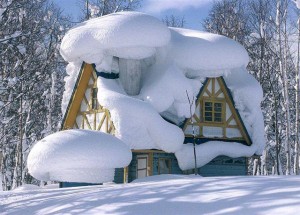When cold weather approaches, it becomes necessary to winterize the home. Winter weather can cause tremendous damage to a home, which is why it is important to complete a few tasks. Some jobs can be done without assistance, while others may require professional assistance. Here is a look at the best ways to get the house ready for winter.
Windows
Windows with poor insulation will be a nightmare in the winter. Heat will escape and make electric bills extremely high. The first thing that a homeowner should consider is caulking areas around windows to block out a path for cold air to enter or warm air to escape. Other people should consider buying new storm windows. Storm windows can be expensive, so it may be better to research other ways to prepare windows.
One of the cheapest ways to insulate the areas around windows is to use a plastic film kit. These kits are readily available at a low price at any home improvement store. The plastic tapes over window panels in hopes of keeping warm air in the room.
Plants
It is essential to care for outdoor plants before winter sets in. Most plants will enter a dormant stage during cold months. Before snow approaches, it is wise to apply a slow release fertilizer to any outdoor shrub or plant. It is also helpful to add a new layer of mulch. Potted plants should be taken inside or left in a protected area like a garage or covered porch. The pots should be wrapped with foam to protect the plant’s roots.
Roofs And Gutters
It is important to get on the home’s roof before winter strikes. The flashings must be in good condition and all loose or missing shingles must be replaced. The gutters must be cleaned to make sure all downspouts are free of debris. It may be smart to install leaf guards on downspouts which will keep water from causing damage to the home.
Plumbing
One of the most important ways to winterize a home is to properly prepare the plumbing. The first step is to examine all pipes and look for possible leaks or other problems. Even a tiny leak can become a tremendous headache as freezing temperatures approach. If a home contains insulated pipes, it is best to feel for any signs of moisture. If leaks are too severe, it may be time to consult a professional plumber. This expert will be able to solve any problems and also recommend the best way to keep pipes from freezing.
One of the best ways to prevent frozen pipes is to add insulation to pipes that are exposed to the elements. The best place to apply this insulation is over pipes in attics, garages, or crawl spaces. Most home improvement stores carry preformed foam that fits easily on top of open pipes.
A hot water heater must be insulated as well. A hot water heater is a common place where heat can become lost, especially when it is located in a cold basement. An insulation blanket can be purchased at any hardware store and placed over the unit. It is a very cost effective way to maximize energy usage.
When a home has an evaporator cooler, it is essential to have it drained proper to the winter chill. The water must be turned off in the house and the unit must be powered off as well. The water must be drained from the cooler and the supply line. This is a good opportunity to perform some cleaning inside the unit. The last step is to cover the equipment to keep it dry all winter.
Outside of the home, certain plumbing issues must be addressed before winter as well. All garden hoses must be disconnected and drained. This will keep hose bibs free from causing damage to exterior pipes.
If a home is located in an extremely cold climate, it may be best to install a shutoff valve inside of the faucet. All pipes must be completely drained by opening the bibs and letting all water escape. Without a shutoff valve, the hose bib can be covered or insulated during winter months. This is a cheap way to keep pipes from freezing.
If a home has a sprinkler system, this must be winterized as well. Similar to the hose bib, this irrigation system must be turned off and flushed of water. This process will help to avoid headaches when spring and summer arrives.
The air conditioner pipes must be drained and the water shutoff valve must be turned off. Some people go away for the winter season to a warmer climate. It is best to keep the heat turned on, but at a low 55 degrees. This will keep the temperature from dipping too low and causing problems.
Finally, it is essential for a homeowner to locate the main water valve into the house. When an emergency arises, it will be essential to know where the water can be shut down quickly. The water main controls all of the water that enters the home.
There are many tasks involved with winterizing a home. It is essential to seal all air leaks and to take care of the plumbing inside and outside of the home. When a home is properly winterized, it will be energy efficient and free from damage. Despite the small costs involved, it is always better to take preventative measures instead of making emergency repairs.